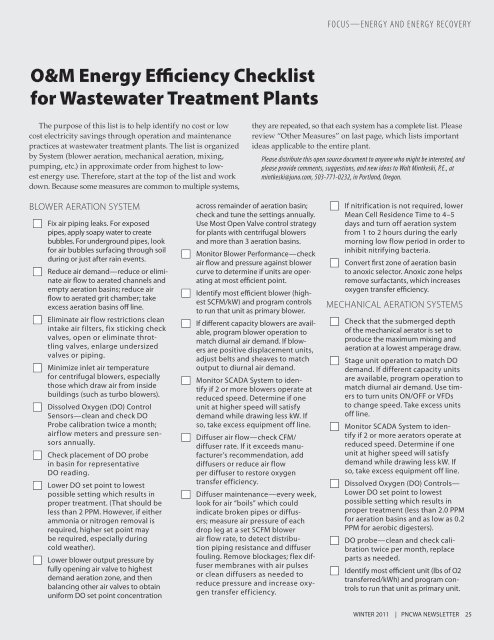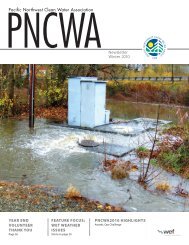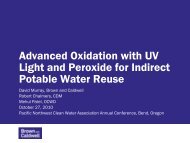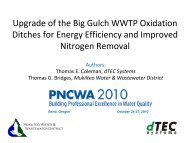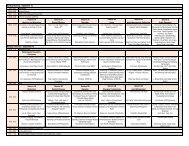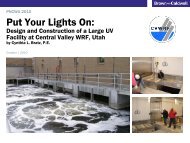Pacific Northwest Clean Water Association ... - PNCWA Home
Pacific Northwest Clean Water Association ... - PNCWA Home
Pacific Northwest Clean Water Association ... - PNCWA Home
- No tags were found...
Create successful ePaper yourself
Turn your PDF publications into a flip-book with our unique Google optimized e-Paper software.
FOCUS—ENERGY AND ENERGY RECOVERYO&M Energy Efficiency Checklistfor Wastewater Treatment PlantsThe purpose of this list is to help identify no cost or lowcost electricity savings through operation and maintenancepractices at wastewater treatment plants. The list is organizedby System (blower aeration, mechanical aeration, mixing,pumping, etc.) in approximate order from highest to lowestenergy use. Therefore, start at the top of the list and workdown. Because some measures are common to multiple systems,they are repeated, so that each system has a complete list. Pleasereview “Other Measures” on last page, which lists importantideas applicable to the entire plant.Please distribute this open source document to anyone who might be interested, andplease provide comments, suggestions, and new ideas to Walt Mintkeski, P.E., atmintkeski@juno.com, 503-771-0232, in Portland, Oregon.BLOWER AERATION SYSTEM■■Fix air piping leaks. For exposedpipes, apply soapy water to createbubbles. For underground pipes, lookfor air bubbles surfacing through soilduring or just after rain events.■■Reduce air demand—reduce or eliminateair flow to aerated channels andempty aeration basins; reduce airflow to aerated grit chamber; takeexcess aeration basins off line.■■Eliminate air flow restrictions cleanintake air filters, fix sticking checkvalves, open or eliminate throttlingvalves, enlarge undersizedvalves or piping.■■Minimize inlet air temperaturefor centrifugal blowers, especiallythose which draw air from insidebuildings (such as turbo blowers).■■Dissolved Oxygen (DO) ControlSensors—clean and check DOProbe calibration twice a month;airflow meters and pressure sensorsannually.■■Check placement of DO probein basin for representativeDO reading.■■Lower DO set point to lowestpossible setting which results inproper treatment. (That should beless than 2 PPM. However, if eitherammonia or nitrogen removal isrequired, higher set point maybe required, especially duringcold weather).■■Lower blower output pressure byfully opening air valve to highestdemand aeration zone, and thenbalancing other air valves to obtainuniform DO set point concentrationacross remainder of aeration basin;check and tune the settings annually.Use Most Open Valve control strategyfor plants with centrifugal blowersand more than 3 aeration basins.■■Monitor Blower Performance—checkair flow and pressure against blowercurve to determine if units are operatingat most efficient point.■■Identify most efficient blower (highestSCFM/kW) and program controlsto run that unit as primary blower.■■If different capacity blowers are available,program blower operation tomatch diurnal air demand. If blowersare positive displacement units,adjust belts and sheaves to matchoutput to diurnal air demand.■■Monitor SCADA System to identifyif 2 or more blowers operate atreduced speed. Determine if oneunit at higher speed will satisfydemand while drawing less kW. Ifso, take excess equipment off line.■■Diffuser air flow—check CFM/diffuser rate. If it exceeds manufacturer’srecommendation, adddiffusers or reduce air flowper diffuser to restore oxygentransfer efficiency.■■Diffuser maintenance—every week,look for air “boils” which couldindicate broken pipes or diffusers;measure air pressure of eachdrop leg at a set SCFM blowerair flow rate, to detect distributionpiping resistance and diffuserfouling. Remove blockages; flex diffusermembranes with air pulsesor clean diffusers as needed toreduce pressure and increase oxygentransfer efficiency.■■If nitrification is not required, lowerMean Cell Residence Time to 4–5days and turn off aeration systemfrom 1 to 2 hours during the earlymorning low flow period in order toinhibit nitrifying bacteria.■■Convert first zone of aeration basinto anoxic selector. Anoxic zone helpsremove surfactants, which increasesoxygen transfer efficiency.MECHANICAL AERATION SYSTEMS■■Check that the submerged depthof the mechanical aerator is set toproduce the maximum mixing andaeration at a lowest amperage draw.■■Stage unit operation to match DOdemand. If different capacity unitsare available, program operation tomatch diurnal air demand. Use timersto turn units ON/OFF or VFDsto change speed. Take excess unitsoff line.■■Monitor SCADA System to identifyif 2 or more aerators operate atreduced speed. Determine if oneunit at higher speed will satisfydemand while drawing less kW. Ifso, take excess equipment off line.■■Dissolved Oxygen (DO) Controls—Lower DO set point to lowestpossible setting which results inproper treatment (less than 2.0 PPMfor aeration basins and as low as 0.2PPM for aerobic digesters).■■DO probe—clean and check calibrationtwice per month, replaceparts as needed.■■Identify most efficient unit (lbs of O2transferred/kWh) and program controlsto run that unit as primary unit.WINTER 2011 | <strong>PNCWA</strong> NEWSLETTER 25


